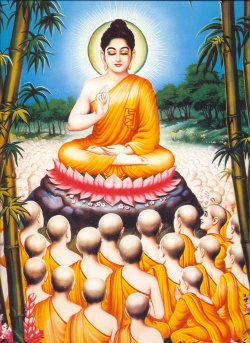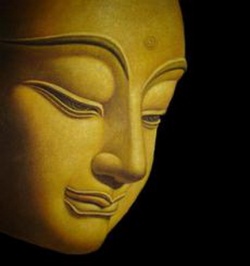Dharmadhatu By Yutang Lin
The Sanskrit word "dharma" occurs frequently in Buddhist works. In Buddhist works "dharma" basically has two kinds of meanings. The first kind means truth. Truth has no exceptions and could not be disobeyed; due to such law-like characteristics, in Chinese Buddhist works, "dharma" is translated by the Chinese character Fa that means law. (In Chinese Buddhist works there are also transliterations of "dharma" such as Da Mo.) In this light rules and norms that are in accordance with truth and teachings that illustrate truth are also called "dharma." Buddha’s teachings aim at guiding sentient beings to live in accordance with truth; hence it is called "Buddha Dharma" or simply "Dharma." The second kind of meaning of "dharma" is a general noun used to denote anything. In this sense "dharma" resembles "thing" in their linguistic uses. Nevertheless, according to Buddhist teachings there is nothing that has an absolutely independent existence; consequently, what is meant by "dharma" is not limited to objects or events that are commonly regarded as existent or real. Instead, it could refer to anything thinkable or imaginable, even including products of illusion or delusion. Furthermore, it could also refer to spiritual states that transcend senses and consciousness, and are unspeakable or unimaginable. Under this meaning of "dharma" all dharmas are mutually dependent causes and conditions of their coexistence. Whatever the ordinary worldly view may be, in this sense of "dharma," all dharmas are equal as one of the dharmas and this equality transcends considerations of their differences in being real/unreal, superior/inferior, or abundant/deficient. In this sense of "dharma" the word "dharmadhatu," literally "realm of dharmas," refers to the collection of all dharmas. "Attaining Buddhahood" means having transcended all and any limitations that are due to artificial concepts, subconscious activities, desires and feelings, will and attachment, time and space, etc., and having regained the original state of dharmadhatu in harmonious oneness. To a being that has attained Buddhahood dharmadhatu is also referred to as the Dharmakaya, literally "body of dharmas," of that being. Thus we see that understanding the notion of dharmadhatu plays an essential role in successful quest for Buddhahood. In order to attain Buddhahood we need to comprehend correctly and thoroughly the full significance of "dharmadhatu." This essay is composed to expound the correct content of "dharmadhatu" and to point out some essential features that are commonly confused with other notions. I hope that this work will help people advance on the right path toward Buddhahood.
1. Dharmadhatu is not just the universe.
Universe is the collection of all things in time and space. Yet dharmadhatu is neither limited by space nor by time. There are boundless sorts of states that are beyond the sphere of time and space; there are also limitless objects and events that are not within the sphere of time and space. Dharmadhatu transcends any limitation; it is much more comprehensive than the universe.
2. All of dharmadhatu coexist as a whole.
It is commonly held to be the case that what was in the past are gone, what are at present are transient, and what will come have not yet occurred. Consequently, even though after having accepted the Dependent Origination View that all dharmas are mutually dependent as causes and conditions for their coexistence, one still regards dharmadhatu as a flow of dharmas—past dharmas have faded away, present dharmas are apparent but transient, and future dharmas have not arrived and are unpredictable. This view of dharmadhatu is under the limitation of the notion of time, and as such it deviates from the correct meaning of the Buddhist dharmadhatu. Dharmadhatu is neither limited by space nor by time. According to the correct view of dharmadhatu all dharmas in the past, all dharmas at present and all dharmas in the future are all together in the dharmadhatu. Ordinarily people can experience only a minute part of all dharmas at present, and therefore people sustain the view that dharmas in the past are gone and future is unpredictable. If one practices according to Buddhist teachings and thereby comes out of the bondage of the fixed view of a space-and-time framework, then it is possible to experience or witness dharmas in the past as well as dharmas in the future. According to biographies of ancient Buddhist sages, some witnessed that the ancient assemblage of Buddha, holy beings and his disciples, in which the teachings recorded in Wondrous Dharma Lotus Sutra were given, had not dispersed yet. There are also numerous records of valid prophecies regarding important events or personages in Buddhist history. Even though for common people these matters are difficult to believe, nevertheless, among practitioners it is common experiences that knowledge of future events are revealed now and then through inspirations. On my part, I once saw in a dream the streets of San Francisco with people and carriages that seemed to be a scene at the period near the turn of 19th and 20th centuries. This experience rekindled my attention to the Buddhist sage’s experience of witnessing the ancient Dharma assemblage, and helped me to have complete faith in that record.
3. Dharmadhatu transcends differentiation.
All dharmas are mutually dependent and coexist. Distinctions of real/unreal, existent/extinct, apparent/concealed, higher/lower, etc., are based on grasping to appearances as the results of our conscious choices and attachments. Discriminations made neither increase nor decrease dharmadhatu in any way; distinction making has no significance whatsoever to dharmadhatu. In order to attain realization of oneness of dharmadhatu we need to recognize this point clearly, and relinquish grasping to the habit of making conscious distinctions.
The three points mentioned above are essential to correct comprehension of the significance of "dharmadhatu" that would enable realization of attainment. Even though these ideas are hard to comprehend and even harder to believe, they are statements based on both studies of Buddhist teachings and experiences gained through long-term practices. I hope that Buddhists in general would pay attention to these points and thereby realize enlightenment sooner.
Source
By Yutang Lin
yogichen.org

